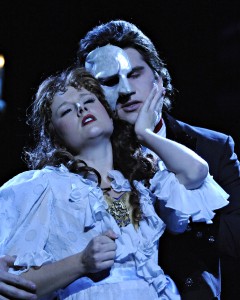This winter, BYU students are invited to “start a journey to the strange new world” of “The Phantom of the Opera.” The BYU production brings the thrilling theater classic to the de Jong Concert Hall of the Harris Fine Arts Center with large sets, gorgeous costumes and beautiful sound.
The phantom of the Paris opera house is a gruesome ghost and legend among the 19th century opera house’s cast. The phantom’s reign of terror is kept in check when the opera’s owner meets his series of specific demands. However, the owner grows tired of the constant stress and sells the theater. The new owners refuse to play the phantom’s game of power. They are not aware that this is a dangerous time to challenge the ghost — he has fallen in love with an innocent young rising star, Christine. Despite the advice of her friends, Christine surrenders to the “music of the night” and a nightmare begins for everyone involved with the Paris Opera House.

“The Phantom of the Opera” is one of the great classics of American musical theater, so any production off of Broadway opens its curtains to some high expectations. The singing, the acting, effects, set and the much-anticipated chandelier crash are all viewed with intense scrutiny.
Any time a Broadway musical leaves its traditional venue, the major source of angst for theater lovers is the singing, as demonstrated by the critical lambasting of movie stars’ musical talent in the December 2012 movie version of “Les Miserables.” However, the BYU production of “Phantom of the Opera” has no such problem. The singing was clear and strong. Both DeLaney Westfall, as Christine, and Preston Yates, as the Phantom, outdid themselves as college performers.
In fact, the entire in-theater sound experience was enjoyable. When the “ghostly” sound of the Phantom’s organ burst into the theater during the Overture, it was as loud and powerful as the audience could have wished. The BYU Wind Symphony played live for the entire production. The base shook the center seats in the orchestra seating, and the Phantom’s voice surrounded the entire theater several times. There was no doubt that the Phantom “was there.”
Costumes and set were everything one wants in a period theater piece. There were no complete set changes, but a ghostly boat rows across a foggy lake, and a clever use of set doubles keeps the audience guessing about where they really are.
The only significant difference in this production was the chandelier. It is supposed to crash dramatically and frighteningly down onto the stage as though it has suddenly been cut from the ceiling. However, this light fixture swayed earthward as though it were being gently lowered by a cable — which it was, but the audience wasn’t supposed to know that.
This winter, “The Phantom of the Opera” will get “inside the mind” of many people in Utah. The BYU production spared no expense in putting on one of the biggest shows of the 20th century.




